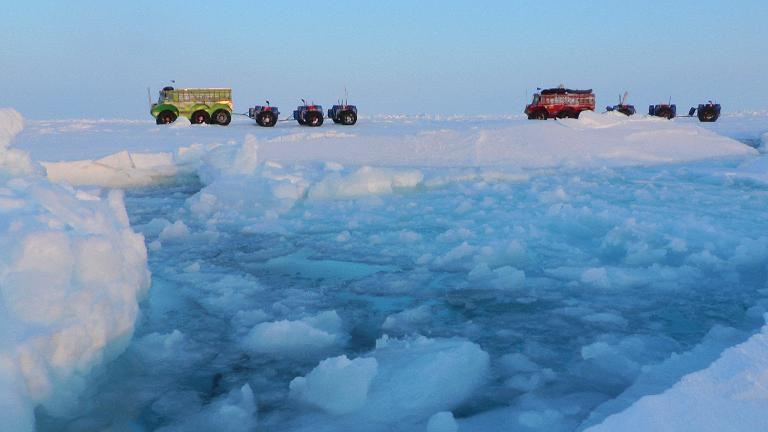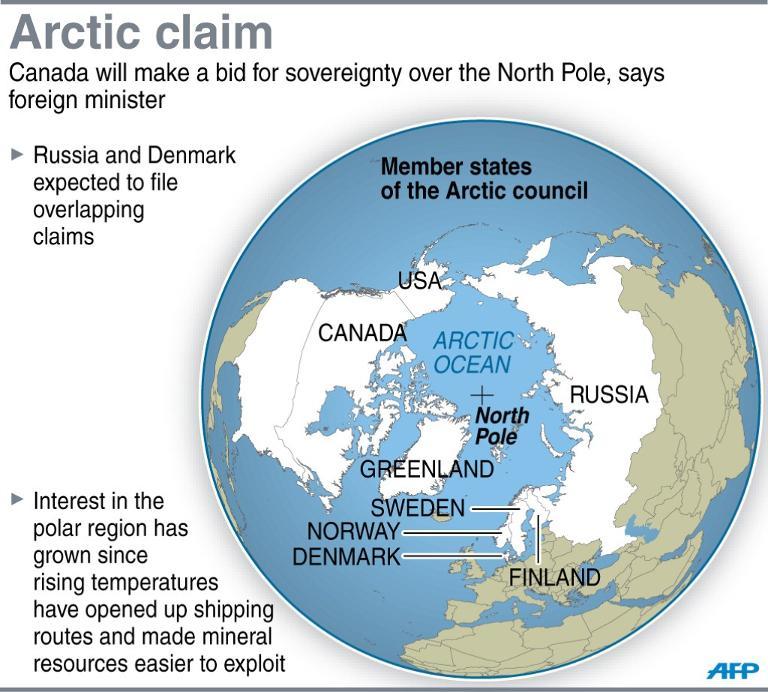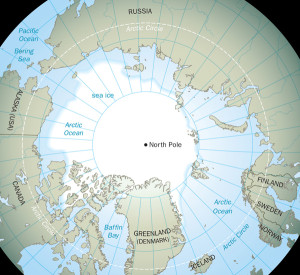redo Jump to...
print Print...
(from the Associated Press posted at USA Today) TORONTO – Canada plans to make a claim to the North Pole in an effort to assert its sovereignty in the resource-rich Arctic, the country’s Foreign Affairs Minister John Baird said Monday.

In this undated image from by the Marine Ice Automobile Expedition, two trucks used by the expedition members cross the North Pole. (AFP/Marine Ice Automobile Expedition)
Mr. Baird said the government has asked scientists to work on a future submission to the United Nations claiming that the outer limits of the country’s continental shelf include the pole, which so far has been claimed by no one.
Canada last week applied to extend its seabed claims in the Atlantic Ocean, including some preliminary Arctic claims, but it wants more time to prepare a claim that would include the pole.
Asserting Canada’s rights in the Arctic has been a popular domestic issue for Prime Minister Stephen Harper, though at least one expert on the issue described the planned claim as a long shot.
“We are determined to ensure that all Canadians benefit from the tremendous resources that are to be found in Canada’s far north,” Baird said.
Countries including the U.S. and Russia are increasingly looking to the Arctic as a source of natural resources and shipping lanes. The U.S. Geological Survey says the region contains 30 percent of the world’s undiscovered natural gas and 15 percent of oil. If Canada’s claim is accepted by the UN commission, that would dramatically grow its share.

Countries must submit proposals to the U.N. Commission on the Limits of the Continental Shelf to request an extension of their nautical borders. Currently, under international law, Canada, Denmark, Norway, Russia and the U.S. – the five countries with territories near the Arctic Circle – are allotted 200 nautical miles from their northern coasts.
Under the U.N. Convention on the Law of the Sea, exclusive claims can be vastly expanded for Arctic nations that prove that their part of the continental shelf extends beyond that zone.
Baird said Canada’s submission last week set out the potential outer limits of the country’s continental shelf in the Atlantic – a claim of about 750,000 square miles. He said that’s roughly the size of Alberta and Saskatchewan combined.
Canada’s follow-up submission will include a claim to the Lomonosov Ridge, an undersea mountain range between Ellesmere Island, Canada’s most northern land mass, and Russia’s east Siberian coast. That claim would extend Canada’s claim 200 nautical miles beyond the North Pole. [Russia, Canada and Denmark all say the Lomonosov Ridge, which stretches 1,120 miles across the pole under the Arctic Sea, is part of their own landmass.]
 The submission that Canada filed with the U.N. is essentially a series of undersea co-ordinates that map what the government claims is the country’s extended continental shelf.
The submission that Canada filed with the U.N. is essentially a series of undersea co-ordinates that map what the government claims is the country’s extended continental shelf.
Baird said it’s a mammoth task, and the government needs more time to complete the mapping in the Arctic and get its U.N. submission right. “That’s why we have asked our officials and scientists to do additional and necessary work to ensure that a submission for the full extent of the Continental Shelf in the Arctic includes Canada’s claim to the North Pole,” he said.
The U.N. submission is also political, said Michael Byers, an expert on Arctic and international law at the University of British Columbia.
“(Harper) does not want to be the prime minister seen publicly as having surrendered the North Pole, even if the scientific facts don’t support a Canadian claim,” Byers said. “What he’s essentially doing here is holding this place, standing up for Canadian sovereignty, while in private he knows full well that position is untenable.”
The UN submissions do not lead to a binding decision, but lay the groundwork for future country-to-country negotiations over competing territorial claims in the Arctic that could take years to resolve. Just checking the science on a claim likely will take five years, said Rob Huebert, an Arctic expert at the University of Calgary. …
Reprinted here for educational purposes only. May not be reproduced on other websites without permission from USA Today. Visit the website at usatoday.com.
Questions
1. What is a continental shelf – How does the UN Convention on the Law of the Sea define the continental shelf? (see “Background” for this answer)
2. What claim did Canada make last week; what claim will it make soon?
3. a) How can a country get world recognition of a claim to an extension of its nautical borders?
b) What does the Law of the Sea enable “Arctic” nations to do?
4. Name the five countries with territories near the Arctic Circle.
5. a) For what reason are countries including the U.S. and Russia looking to the Arctic?
b) How much natural gas and oil does the U.S. Geological Survey estimate is in the Arctic region?
c) What benefit would Canada gain if its claim is accepted by the UN Commission?
6. Why are the chances that the Commission will accept Canada’s claim improbable?
Background
Under the United Nations Convention on the Law of the Sea, the name continental shelf was given a legal definition as the stretch of the seabed adjacent to the shores of a particular country to which it belongs. (from wikipedia)
The Law of the Sea treaty:
- The United Nations Convention on the Law of the Sea (UNCLOS), also called the Law of the Sea Convention or the Law of the Sea treaty, is the international agreement that resulted from the third UN Conference on the Law of the Sea, which took place between 1973 and 1982.
- The Law of the Sea Convention defines the rights and responsibilities of nations in their use of the world’s oceans, establishing guidelines for businesses, the environment, and the management of marine natural resources.
- As of August 2013, 165 countries and the European Union have joined in the Convention. However, it is uncertain as to what extent the Convention codifies customary international law.
- While the Secretary General of the United Nations receives instruments of ratification and accession and the UN provides support for meetings of states party to the Convention, the UN has no direct operational role in the implementation of the Convention. There is, however, a role played by organizations such as the International Maritime Organization, the International Whaling Commission, and the International Seabed Authority (the latter being established by the UN Convention).
- Although the U.S. helped shape the Law of the Sea Treaty and its subsequent revisions, and though it signed the 1994 Agreement on Implementation, it has not signed the Convention.
- In July 2012, the U.S. Senate had 34 Republican Senators who indicated their intention to vote against ratification of the Treaty if it comes to a vote.
- Since at least 2/3 of the 100 member Senate (at least 67 Senators) are required to ratify a treaty, consideration of the treaty was deferred again.
- Some American commentators, including former Secretary of Defense Donald Rumsfeld, have warned that ratification of the Law of the Sea Treaty might lead to its taxing authority being extended to cover the resources of outer space. (from wikipedia)
The Commission on the Limits of the Continental Shelf:
Purpose of the Commission
The purpose of the Commission on the Limits of the Continental Shelf (the Commission or CLCS) is to facilitate the implementation of the United Nations Convention on the Law of the Sea (the Convention) in respect of the establishment of the outer limits of the continental shelf beyond 200 nautical miles (M) from the baselines from which the breadth of the territorial sea is measured. Under the Convention, the coastal State shall establish the outer limits of its continental shelf where it extends beyond 200 M on the basis of the recommendation of the Commission. The Commission shall make recommendations to coastal States on matters related to the establishment of those limits; its recommendations and actions shall not prejudice matters relating to the delimitation of boundaries between States with opposite or adjacent coasts.
Functions of the Commission:
(a) To consider the data and other material submitted by coastal States concerning the outer limits of the continental shelf in areas where those limits extend beyond 200 nautical miles, and to make recommendations in accordance with article 76 and the Statement of Understanding adopted on 29 August 1980 by the Third United Nations Conference on the Law of the Sea;
(b) To provide scientific and technical advice, if requested by the coastal State concerned during preparation of such data.
In accordance with article 76(8), the Commission shall make recommendations to coastal States on matters related to the establishment of the outer limits of their continental shelf. The limits of the shelf established by a coastal State on the basis of these recommendations shall be final and binding. (from un.org/depts/los/clcs_new/commission_purpose.htm)
Resources
Read about the Continental Shelf at wikipedia.
Daily “Answers” emails are provided for Daily News Articles, Tuesday’s World Events and Friday’s News Quiz.



